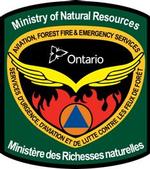Ontario Ministry of Natural Resources, Aviation and Fire Management Branch (OPAS)

"The innovative thinking of the Ontario government, the pilots, air engineers and support staff has resulted in major accomplishments that have benefited Canadian aviation."
One of the earliest provincial forestry aviation services was developed in Ontario, when thirteen Curtiss HS-2L flying boats were purchased in 1924. A modern waterfront structural steel hangar was built at Sault Ste. Marie, and eastern and western division bases were built at Sudbury and Sioux Lookout. A network of sub-bases were located all across Northern Ontario.
The first applications of the airplane by the Ontario Provincial Air Service (OPAS) enabled the Ontario Government's Forestry Branch to obtain an accurate inventory of the type, location and extent of its varied forest resources. With this information, it was possible to determine in which areas lumbering should be encouraged, where and when fire patrols should be made, and how fire suppression activities should be carried out. The first air-to-ground report of a forest fire was made from an OPAS flying boat in 1924, using communications equipment designed by the Air Service.
Technology and innovation related to these issues have been worked out with such consistently good results that both operators and manufacturers of aircraft have turned to the OPAS for advice and guidance in their respective fields. The OPAS made a systematic study of essential aircraft characteristics and collaborated with manufacturers on the design of aircraft suited to northern Canada's needs. Its experience helped greatly in the design of the famous de Havilland Beaver.
OPAS pilots, flying the Beaver and working in cooperation with the National Research Council, have taken part in some outstanding experimental research projects. Excellent work was done on an aircraft ski design in the 1950's. By 1952, a ski suited to all Ontario snow conditions was approved by the Department of Transport. During that period, several other successful experiments were carried out: waterbombing as a means of fire suppression, parachuting supplies to ground parties, and the use of a radar device to assist in glassy water landings. In a different field, some original and successful research was done on aerial fish planting, with a view to stocking Ontario lakes with suitable species. In the 1940's, a Canso was adapted as a spray plane to combat wide-spread forest insect infestations.
OPAS fitted their aircraft with air-to-ground loud speakers, which were used by pilots to direct firefighters, contact lost persons and warn tourists of impending dangers.
Research and experiments in waterbombing has progressed to where smaller, specially-equipped sea planes can pick up in excess of 2,000 litres of water in a matter of seconds, attack a fire and return, time after time. These aircraft, along with the heavy waterbombers, are successful in holding the spread of fire, giving ground forces the time they need to set up and put the fire out.
Low level drops by parachute of fire pumps, hoses, fuel, shovels, axes, radio, camping gear and food enable the ground crews to complete the job. Delivery of fire crews and their equipment directly to a fire scene is a task now assigned to helicopters.
OPAS has a reputation for excellence. Over the years, personnel from its ranks went on to high levels of achievement, winning the Harmon and Trans-Canada (McKee) Trophies, becoming air vice-marshals, deputy minister, member of the Air Transport Board, and DOT inspectors. Many have been inducted as Members of Canada's Aviation Hall of Fame.
Although the name has changed to the Aviation and Fire Management Branch of the Ministry of Natural Resources, today's air service still conducts many of the same duties. Air service fixed wing and rotary aircraft are utilized in a number of additional functions, including: general and executive transport, wildlife census, photography platform, an innovative rabies bait program, fish and wildlife enforcement, flood patrol, infrared sensing, demonstrations and search and rescue.
The Belt of Orion Award for Excellence was awarded to the Ontario Ministry of Natural Resources, Aviation and Fire Management Branch, in 1991.
The 1991 fleet of the Ontario Ministry of Natural Resources, Aviation and Forestry Branch, consisted of nine CL-215 heavy water bombing aircraft, six DHC-6 Twin Otter utility aircraft, twelve DHC-2 Turbo Beavers, two King Airs, one Navajo and six light and medium helicopters. Also maintained are the world’s oldest flying Beaver, and the restored Fairchild KR-34 Biplane - both reflections of a proud history.
